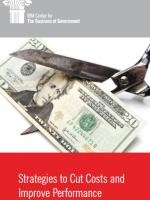
Strategies to Cut Costs and Improve Performance

Observers believe the President’s National Commission on Fiscal Responsibility and Reform (The Debt Commission), which is charged with developing such a plan, may set a target of reducing the deficit by about $7 trillion over a 10-year period. If such a deficit-reduction plan is to be credible, the federal government must adopt an aggressive spending reduction program that includes reforming entitlement programs, eliminating low-priority programs, and adopting commercial best practices in government operations.
We estimate that through a combination of spending reforms in these three areas, the federal government can save $1–1.5 trillion over five years and up to $2–3 trillion over ten years. Approximately $1 trillion of those savings can be generated by adopting commercial best practices in government operations. It is our belief that existing technologies can significantly reduce costs and improve service quality. This has been IBM’s direct experience in the commercial world and we see no obvious reason why the federal government cannot achieve similar results.
In real terms, government organizations at all levels of government are being asked not only to do more with less, but to adjust their missions to today’s demands and expectations. Many commercial best practices have been adopted to help commercial organizations save money while becoming more competitive—essentially, doing more with less. At IBM, we’re maniacally focused on adopting such practices.
We propose implementing new approaches to improve performance while reducing cost in a more meaningful way—one that will enhance mission value provided by departments to citizens, state and local governments, businesses, etc.
This report provides specific strategies that the federal government can undertake to achieve savings in operational functions. A brief description of each cost-saving strategy is presented on the following pages. Additional information on each strategy will be provided and discussed on Strategies to Cut Costs and Improve Performance Blog.



